Marni Wasserman’s journey started with a bit of uncertainty, but eventually took shape as she found her passion in biomechanics. Graduating with a background in writing and psychology from NYU, Wasserman found herself at the University of Michigan, where she completed her master’s in Movement Science in December 2023.
Her academic path took a significant turn when she connected with Dr. Alex Lempke, a former Human Performance & Sport Science Center (HPSSC) faculty member, during an orientation session when she came to U-M. Bonding over a shared interest in running, Wasserman found herself drawn to the Michigan Performance Research (MiPR) Lab, HPSSC’s core research lab, whose mission is to support active individuals by investigating the biomechanics and physiology of human performance. She initially volunteered as a graduate student, assisting with data collection and familiarizing herself with the software and hardware used in the research lab. Being a runner herself and already familiar with wearable technology, this was a perfect opportunity to connect a passion with her academics.
Her involvement in the lab was a transformative one, as she gained experience through projects centered on wearable technology and data analysis, particularly focused on improving technologies like VO2 max monitoring. Notably, an abstract submission for the American College of Sports Medicine (ACSM), originating from a project within her program, led her to meet her current PhD advisor at Indiana University Bloomington, where she studies Human Performance with a specialization in biomechanics, specifically related to running and gait.
Wasserman noted that the structured environment of her MiPR lab experience during her time at Michigan offered her essential lessons in organization and management. Reflecting on her journey, she emphasizes the importance of taking initiative and seeking mentorship to deepen understanding and explore interests. She highlights the evolving landscape of wearable technology and how she’s witnessed it becoming more accurate, and throws a nod to Coros as her preferred watch brand, particularly for its accuracy in monitoring running metrics.
For prospective students, Wasserman emphasizes the value of hands-on experience in a research lab like MiPR, noting its role in bridging academic knowledge with practical skills, along with professional networking.
“The hands-on application helped me gain a deeper understanding of what I was learning and how to do research”, said Wasserman.
As she navigated the balance between coursework and lab commitments as a part-time student, Wasserman found the workload manageable and wants students to know that there are so many resources and opportunities available to them. Still, they have to take the initiative to seek them out.
Ultimately, Wasserman’s story serves as an inspiring testament to the power of academic exploration and experiential learning, showcasing the role of research labs in shaping future careers and fostering innovation in the field of human performance and biomechanics.
